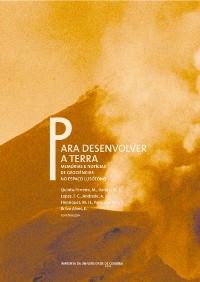Please use this identifier to cite or link to this item:
https://hdl.handle.net/10316.2/31454| Title: | Utilização do GPR para auxiliar na compreensão da evolução da paisagem: estudo de caso do Parque Estadual Veredas do Peruaçu: MG, Brasil | Other Titles: | The use of the GPR to interprete the landscape evolution: a case of study from Parque Estadual Veredas do Peruaçu - MG | Authors: | Aranha, P. R. A. Augustin, C. H. R. R. |
Keywords: | lagoon system;Veredas;Disconection;GPR;Sistema laguna;Veredas;Desconexão;GPR | Issue Date: | 2012 | Publisher: | Imprensa da Universidade de Coimbra | Journal: | http://hdl.handle.net/10316.2/24404 | Abstract: | System of lagoons located in arenaceous lands of Supergrupo Urucuia, in
the State Park Veredas do Peruaçu, north of the State of Minas Gerais, Brazil, are common
features in ecosystems of veredas, a bioma of the Cerrado (Savannah‑Open
pasture).
The linearity of these lagoons suggests that the same ones can have, in the past, belonged to
the same system, that would have been disconnected throughout the evolution of the lagoon
system. The objective of this research is with the help of the GPR and using 100 MHz antennaes
to obtain radargram images that could assist in the interpretation of the structures
occurring at the bottom of one of these lakes (a dry lake). The results of these radargrames
indicate a great conformity between the concave form of the sediments and that of the bottom
of the lake, allowing assuming has been occurring since a long time ago. Therefore,
if there was a connection between the study lake and those located in its proximity it has
occurred a long time, before the deposition of the sequences had been deposited. The thickness
of the sediments, 2m, indicates, that or this deposition was either a very rapid one so
that could generate a fast deposition, or it has been taking place during a considerable long
geologic time. Sistema de lagoas localizadas em terrenos arenosos do Supergrupo Urucuia, no Parque Estadual Veredas do Peruaçu, norte do Estado de Minas Gerais, Brasil, são feições comuns nos ecossistemas das veredas, do bioma do Cerrado. A linearidade dessas lagoas sugere que as mesmas possam ter, no passado pertencido a um mesmo sistema, que teria sido deconectado ao longo da evolução da mesma. O objetivo desta pesquisa foi, com o auxílio do GPR e utilizando antenas de 100 MHz gerar imagens de radargrama que pudessem auxiliar na interpretação das estruturas do fundo de uma das lagoas que formam esse complexo. Resultados desses radargramas indicam uma conformidade muito grande entre a forma abaulada (côncava) do fundo e os sedimentos que alí estão depositados, permitindo assumir que se houve conexão entre a lagoa estudada e as demais localizadas em sua proximidade, isto ocorreu há muito tempo, bem antes da deposição da sequência sedimentar. A espessura 2m do pacote sedimentar indica, que ou houve uma sedimentação muito rápida e intensa que pudesse gerar essa espessura, ou ela vem ocorrendo há um tempo geológico considerável. |
URI: | https://hdl.handle.net/10316.2/31454 | ISBN: | 978-989-26-0531-9 (PDF) | DOI: | 10.14195/978-989-26-0531-9_24 | Rights: | open access |
| Appears in Collections: | Para desenvolver a Terra: memórias e notícias de Geociências no espaço lusófono |
Files in This Item:
| File | Description | Size | Format | |
|---|---|---|---|---|
| 24-para_desenvolver_a_terra_artigo.pdf | 1.43 MB | Adobe PDF |  |
Items in DSpace are protected by copyright, with all rights reserved, unless otherwise indicated.
